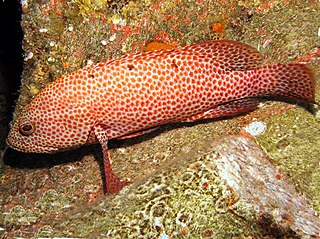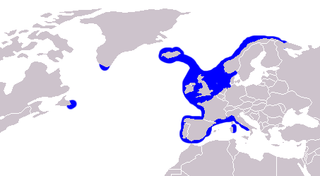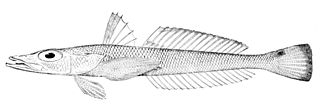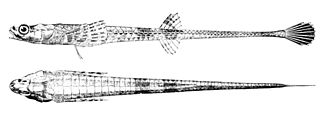
Halibut is the common name for two flatfish in the genus Hippoglossus from the family of right-eye flounders and, in some regions, and less commonly, other species of large flatfish.

Ridgeheads, also known as bigscales, are a family of small, deep-sea stephanoberyciform fish. The family contains approximately 37 species in five genera; their distribution is worldwide, but ridgeheads are absent from the Arctic Ocean and Mediterranean Sea. Although the family is one of the most widespread and plentiful of deep-sea families, none of its members are of interest to commercial fishery.

Pleuronectidae, also known as righteye flounders, are a family of flounders. They are called "righteye flounders" because most species lie on the sea bottom on their left sides, with both eyes on their right sides. The Paralichthyidae are the opposite, with their eyes on the left side. A small number of species in Pleuronectidae can also have their eyes on the left side, notably the members of the genus Platichthys.

The graysby is a species of marine ray-finned fish, a grouper from the subfamily Epinephelinae which is in the family Serranidae which also includes the anthias and sea basses. It is found in the western Atlantic. It is associated with reefs and is a quarry species for commercial and recreational fisheries.

The common ling, also known as the white ling or simply the ling, is a large member of the family Lotidae, a group of cod-like fishes. It resembles the related rocklings, but it is much larger and has a single barbel. This species is unrelated to the pink ling, Genypterus blacodes, from the Southern Hemisphere. The common ling is found in the northern Atlantic, mainly off Europe, and into the Mediterranean Basin. It is an important quarry species for fisheries, especially in the northeastern Atlantic, although some doubts exist as the sustainability of the fisheries. As an edible species, it is eaten fresh, frozen, or dried, but also preserved in lye, while the roe is a delicacy in Spain.
The spiny-back eel, Notacanthus sexspinis, is a deep-sea spiny eel of the genus Notacanthus, found in all the Southern Hemisphere oceans at depths between 500 and 1,000 m. The length of this fish is up to 60 cm (24 in).

The Percophidae, duckbills, are a family of percomorph fishes, from the order Trachiniformes, found in tropical and subtropical waters of the Atlantic and Indian Oceans and in the southwestern and southeastern Pacific.

The ridge scaled rattail or ridge-scaled grenadier, Macrourus carinatus, is a species of deep-water fish in the family Macrouridae. It has southern circumglobal distribution in temperate to subantarctic waters (34°S–65°S) and is found in the Southern Atlantic, Indian and Pacific Oceans and in the Southern Ocean at depths of about 200–1,200 m (660–3,940 ft).

The Atlantic halibut is a flatfish of the family Pleuronectidae. They are demersal fish living on or near sand, gravel or clay bottoms at depths of between 50 and 2,000 m. The halibut is among the largest teleost (bony) fish in the world, and is an endangered species due to a slow rate of growth and previous overfishing. Halibut are strong swimmers and are able to migrate long distances. Halibut size is not age-specific, but rather tends to follow a cycle related to halibut abundance.

Macrourus is a small benthopelagic genus of rattails from the family Macrouridae.

The Greenland halibut or Greenland turbot belongs to the family Pleuronectidae, and is the only species of the genus Reinhardtius. It is a predatory fish that mostly ranges at depths between 500 and 1,000 m (1,600–3,300 ft), and is found in the cold northern Atlantic, northern Pacific, and Arctic Oceans. It has a variety of other English vernacular names, including black halibut, blue halibut, lesser halibut, and Newfoundland turbot; while both Newfoundland turbot and Greenland turbot are in common use in North America, these names are typically not used in Europe, where they can cause easy confusion with the true turbot.

The Bear Seamount is a guyot or flat-topped underwater volcano in the Atlantic Ocean. It is the oldest of the New England Seamounts, which was active more than 100 million years ago. It was formed when the North American Plate moved over the New England hotspot. It is located inside the Northeast Canyons and Seamounts Marine National Monument, which was proclaimed by President of the United States Barack Obama to protect the seamount's biodiversity.

The snowy grouper is a species of marine ray-finned fish, a grouper from the subfamily Epinephelinae which is part of the family Serranidae, which also includes the anthias and sea basses. It is found in the western Atlantic Ocean.

The flathead sole is a flatfish of the family Pleuronectidae. It is a demersal fish that lives on soft, silty or muddy bottoms at depths of up to 1,050 metres (3,440 ft). Its native habitat is the northern Pacific, from the seas of Japan and Okhotsk, across the Bering Sea and to the coast of North America, as far south as Point Reyes, United States. It grows to 52 centimetres (20 in) in length, and can weigh up to 1.56 kilograms (3.4 lb); females are typically larger than males. Lifespan is at least 27 years for females and at least 30 years for males.
Aldrovandia phalacra, the Hawaiian halosaurid, is a species of ray-finned fish in the family Halosauridae. It is a circumglobal species found at bathyal depths.

Coryphaenoides rupestris is a species of marine ray-finned fish in the family Macrouridae. Its common names include the rock grenadier, the roundnose grenadier and the roundhead rat-tail. In France it is known as grenadier de roche and in Spain as granadero de roca. It is a large, deep-water species and is fished commercially in the northern Atlantic Ocean.

Sebastes babcocki is a species of fish in the rockfish family known by the common name redbanded rockfish. Other common names include bandit, barber pole, flag rockfish, Spanish flag, Hollywood, convict, and canary. It is native to the northern and eastern Pacific Ocean. Its distribution extends from the Zhemchug Canyon in the Bering Sea and the Aleutians south to San Diego, California.

The Alligatorfish is a fish in the family Agonidae (poachers). It was described by Marcus Elieser Bloch in 1786. It is a marine, temperate water-dwelling fish which is known from the northwestern Atlantic Ocean, including western Greenland; Labrador, Canada; and Cape Cod, Massachusetts, USA. It dwells at a depth range of 0–695 metres, most often around 60–150 m, and inhabits sand and mud bottoms mostly on the lower continental shelf all year. It prefers a temperature range of -1.07 to 2.52 °C. Males can reach a maximum total length of 22 centimetres, but more commonly reach a TL of 14.2 cm.
Barbantus curvifrons, commonly known as the palebelly searsid, is a species of ray-finned fish known from the Indian Ocean, the Pacific Ocean and the eastern Atlantic Ocean where it has been found at depths below 500 metres (1,600 ft). The generic name Barbantus is derived from the Latin, "barba", a beard.
Trachurus delagoa, the African scad, is a species of jack mackerel from the family Carangidae which is found in the south western Indian Ocean.















